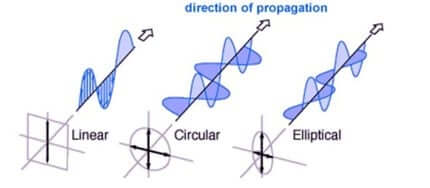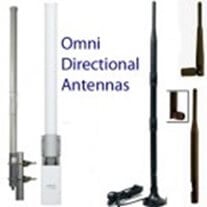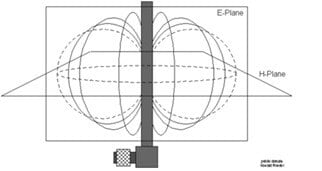Antennas, Antenna Cables, Wireless Products: Technical Articles
Antenna Polarization: Vertical, Linear: Key Factor in Selection of an Antenna
Antenna Polarization:
Polarity is a key electrical characteristic to be considered when selecting an antenna. Like-matched antennas in an RF set-up will have optimal power or signal transfer in point-to-point applications.
- Polarity is as important as gain, radiation pattern and VSWR, in the selection of an antenna.
- Our article on radiation patterns is closely related to polarization and will be very helpful to more fully understand polarization.
In transmitting antennas, the polarization of an antenna is the direction of the electromagnetic fields produced by the antenna as energy radiates away from it. These directional fields determine the direction or E-plane in which the energy moves away from or is received by an antenna. Transmitting and receiving antennas are designed with a specific type of polarization as an intrinsic characteristic.
Types of Polarization:
The most common forms of polarization are Linear and Vertical, but polarization can be any of the following:
- Linear or Vertical Polarization refers to the oscillation of an antennas electrical field on either the horizontal or vertical plane.
- Slant Polarization describes an electromagnetic field that oscillates at a 45 degree angle to the reference plane.
- Circular Polarization (CP) regards a radio wave that rotates as the signal propagates. This rotation can be to the right as in Right Hand Circular Polarization (RHCP) or to the left, as in the case of Left Hand Circular Polarization (LHCP).
- Elliptical Polarization is characterized by an electric field that is propagated in an elliptical helix.
With receiving antennas, only electromagnetic energy that possesses the same polarization as the antenna can be received. An antenna with horizontal polarization cannot receive any electromagnetic energy in a vertical polarizing plane.
The orientation, physical structure and mounting of antennas also determine their polarization. Alignment of the orientation and polarization of transmitting and receiving antennas will improve signal strength and the optimal transfer of power. Linear polarization of antennas is geometrically determined, typically in the direction of the antenna's current.
The effect of mounting of antennas on polarization
The mounting of antennas is a critical consideration in deriving optimal performance especially in the horizontal or vertical plane. A straight dipole antenna will have different polarizations when mounted either horizontally or vertically. Practically speaking, a horizontally polarized antenna will have less loss when mounted near a ceiling and a vertically polarized antenna has been demonstrated to have less loss when mounted near a side wall.
Omni-Directional Antennas

Omni-directional antennas have different polarization and performance compared to linear or directional antennas. These antennas radiate RF energy in all directions perpendicular to the antenna's axis in a characteristic ‘doughnut’-shaped radiation pattern. Omni-directional antennas are usually vertically polarized, though they can be circularly polarized or dual polarized. The omni-directional nature of these antennas can cause reflections, which are mitigated by circular polarization. A circularly polarized omni-directional antenna is insensitive to wave orientation, providing particularly effective performance and gain. In receiving antennas a dual polarized CP omni-directional antenna offers optimal transfer of electromagnetic energy. It is a preferred choice for both transmitting and receiving antennas in wireless transmission and networking.
Within radiofrequency setups, an antenna performs as an electrical interface propagating electromagnetic energy and conducting electrical current. The correct choice of antenna is critical for creating an optimally functioning radio frequency set-up, where the antennas are a precise match in size, mechanics and environmental performance for a desired application.
Wireless Antenna Polarization
Polarization of the wireless antenna is the orientation of the wireless signal with regard to its coverage both horizontally and vertically. Polarization can be vertical, horizontal, circular or combinations of these.
The E-plane and H-plane are reference planes for linearly polarized antenna. This diagram below shows the relationship between the E and H planes for a vertically polarized omni-directional dipole antenna This type is intended for short range meshed networks within its range:








